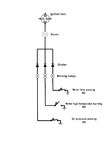Paxman
Newbie

Hi guys!
First post on this forum. I'm from Sweden so English is not my native language so please be patient with my writing and that I might have trouble understanding advanced technical lingo.
What I would love to get some help with is as topic. I'm rebuilding the electrical system in my boat and one of the things I want to incorporate is an audible and visual alarm system to monitor three engine parameters.
There will be three triggers, two normally open (NO) and one normally closed (NC). I'd like each trigger to have a separate warning lamp but here is the kicker, I want only one buzzer to sound in case one, two or all triggers are tripped.
I have done some bench testing with diodes but it's not going well. This is the schematics that I thought would work:

I have tested with LEDs and a car battery but it seems the voltage is too low for the buzzer to sound. Strangely the buzzer I bought is said to work with a 6 to 12 volt span with a draw of 35 mA. The buzzer works fine if I connect it directly to the battery.
I have to admit this is the first time I use diodes so I'm a total noob...
Does anyone see anything wrong with my schematics and/or have any suggestion of how I can get this to work?
Oh, the "54" on the ignition lock is positive feed.
Cheers
Fred (from Sweden)
First post on this forum. I'm from Sweden so English is not my native language so please be patient with my writing and that I might have trouble understanding advanced technical lingo.
What I would love to get some help with is as topic. I'm rebuilding the electrical system in my boat and one of the things I want to incorporate is an audible and visual alarm system to monitor three engine parameters.
There will be three triggers, two normally open (NO) and one normally closed (NC). I'd like each trigger to have a separate warning lamp but here is the kicker, I want only one buzzer to sound in case one, two or all triggers are tripped.
I have done some bench testing with diodes but it's not going well. This is the schematics that I thought would work:

I have tested with LEDs and a car battery but it seems the voltage is too low for the buzzer to sound. Strangely the buzzer I bought is said to work with a 6 to 12 volt span with a draw of 35 mA. The buzzer works fine if I connect it directly to the battery.
I have to admit this is the first time I use diodes so I'm a total noob...
Does anyone see anything wrong with my schematics and/or have any suggestion of how I can get this to work?
Oh, the "54" on the ignition lock is positive feed.
Cheers
Fred (from Sweden)






